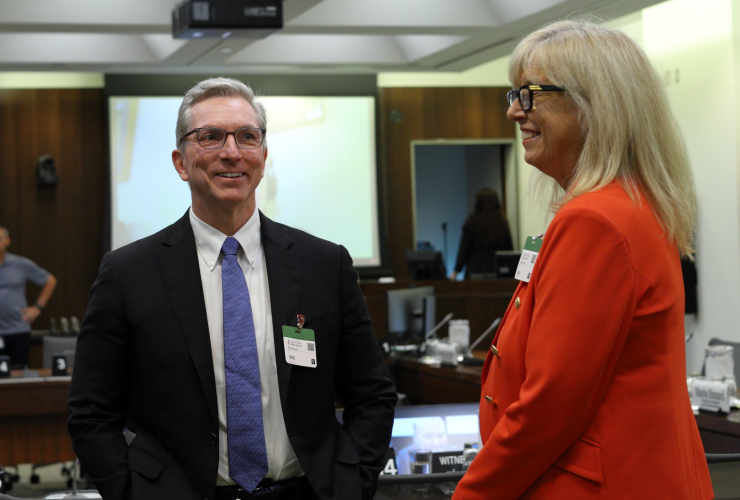Support journalism that lights the way through the climate crisis
Two Atlantic Canadian premiers who have recently been at odds with the federal government over climate policy have presented a united front with Natural Resources Minister Jonathan Wilkinson in their efforts to transition off coal.
Nova Scotia Premier Tim Houston and New Brunswick Premier Blaine Higgs were in Ottawa on Monday for an announcement, where Wilkinson said the federal government has finalized a joint policy statement with the two provinces. Following talks between the parties, he said the federal government will support both provinces in phasing out coal-fired electricity by 2030 (as federally mandated), reach net-zero greenhouse gas emissions from electricity by 2035, and eventually, hit net-zero emissions by 2050.
The announcement comes after last week’s news that the provinces were abandoning the Atlantic Loop to reach their 2030 emissions targets. The loop is a planned energy corridor that aims to connect the Atlantic provinces with hydropower from Quebec and Labrador. Instead, N.B. and N.S. say they will complete the western portion of the loop: an intertie between the two provinces stretching from N.B.’s Point Lepreau nuclear generating station to Salsbury, N.B. to Onslow, N.S.
At the announcement, Wilkinson said there will be two tracks of work to phase out coal by the end of the decade, which includes supporting the provinces in building their intertie. The first track will be focused on finding the investments and federal funding needed for the provinces to make the swap.
Second, Wilkinson said there was agreement on important projects and goals needed for the regions to hit net-zero electricity emissions by 2035. He highlighted small modular nuclear reactors (SMRs) in N.B., offshore wind in N.S., and other renewable projects.
Wilkinson said new funding would build on previous investments, and announced the following money from the federal government will support the provinces in their transition off fossil fuels:
- $11.5 million for N.S. to improve its electrical grid.
- $7 million in support for ARC Clean Technology Canada’s SMR at Point Lepreau.
- $2 million towards converting the Belledune coal-fired generating station in New Brunswick to biomass.
- Approximately $1 million towards the Belledune Port Authority to support turning the area into a “green industrial hub,” said Wilkinson.
While the Atlantic Loop has a price tag of approximately $8 billion, Houston said the intertie will cost between $1 billion and $2 billion. The high cost of the loop, combined with a shift in how much energy Quebec would be able to provide, contributed to the provinces’ decision to not move forward with the plan.
Wilkinson said although electricity is a provincial responsibility, the federal government “obviously wants to support provinces and territories that are bold and creative in terms of trying to ensure that they have a plan to get off coal.”
“I think the amount of electricity that’s available from Quebec is perhaps a bit more constrained than people might have thought a few years ago,” said Wilkinson.
“But it’s also the case, as time has ticked by, that we have come to the realization that it would be very difficult to complete the Atlantic Loop by 2030 even if we were fully on board with moving that.”
As of now, N.S. generates nearly 40 per cent of its power from coal. N.B. generates the same amount from nuclear, and 13 per cent from coal.
The announcement is a contrast to previous talks between the provinces and the federal government about the Loop. In June, Houston criticized the federal government’s $4.5-billion investment in the project for requiring the money to be paid back. In April, Canada’s National Observer reported that the federal government was cutting Newfoundland and Labrador out of the Atlantic Loop project, even though they were included in prior conversations.
Wilkinson highlighted tax breaks through the investment tax credit as a potential revenue stream for the intertie. He said money put towards the tax credit “far exceeds anything that has ever been put into the Strategic Innovation Fund or the Clean Fuels Fund.”
When asked if the federal government would be divvying out direct support, Wilkinson said, “We are going to be bringing all of the tools to the table and having conversations with the province[s].”
Houston said there were important takeaways from his meetings in Ottawa, including that N.S. is on the “same page as to what’s necessary in terms of meeting the targets in a way that everyone is happy or content with to pursue.” He also noted that the areas the provinces need to invest in to get off coal are eligible for federal government funding and that the next step is hammering out details.
He said all three governments are also in agreement that energy needs to be affordable. Overall, he said there was “enough agreement today that I’m optimistic we can get something done that is to the benefit of Nova Scotians and, ultimately, to the benefit of Canadians.”
Higgs, whose government requested permission and was rejected by the federal government to operate the coal-fired Belledune until 2040, said the discussion between the governments was “interesting” and highlighted the need for nuclear, specifically SMRs, for the province to reach its energy targets. Ultimately, the intertie will also position the provinces to be exporters of clean energy, he said.






Comments